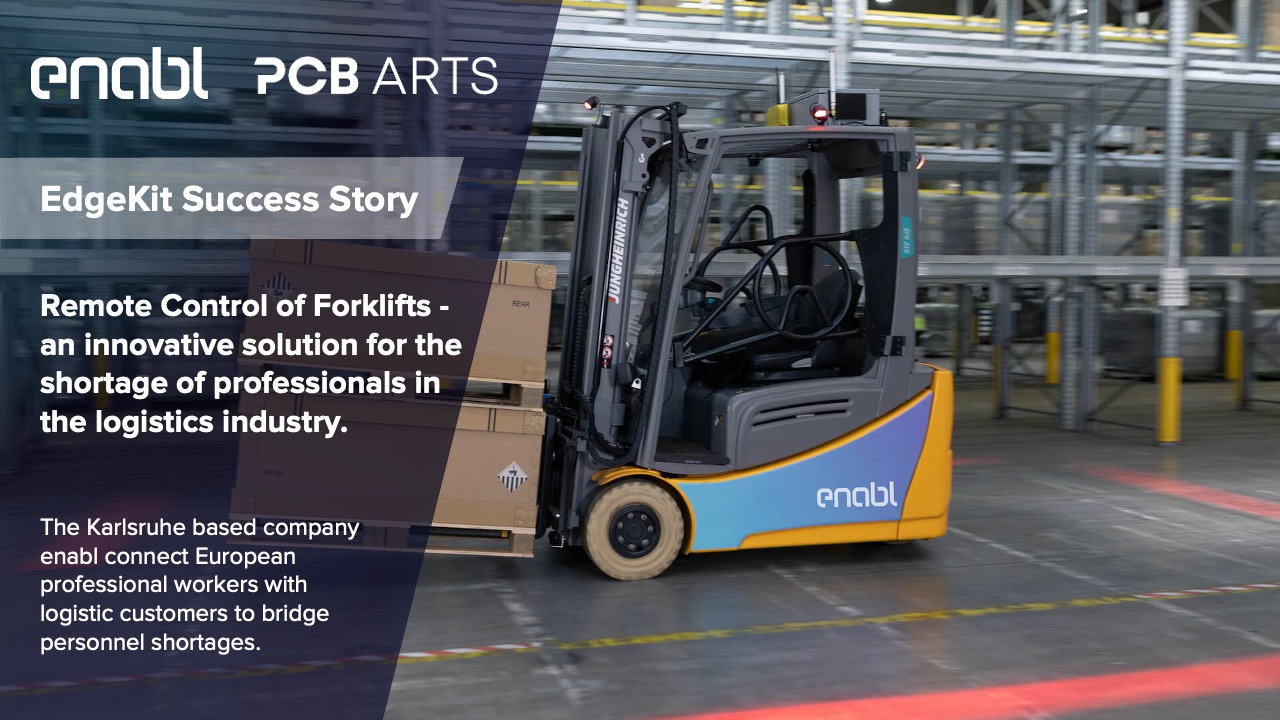Among the most affected sectors of labor shortages in Germany is logistics, which is not only a crucial part of any economy but also its third largest industry in general [1][2]. Unpredictability in order situations makes it hard to keep suited workers ready at all times. An often-cited approach to this situation is automation, but contrary to white-collar sectors, where automation is advancing rapidly, blue-collar sectors will need at least another decade to adapt to these relatively new concepts of technology. Getting a factory ready for full automation is a complex and expensive endeavor as it often requires spaces to change entirely for the needed AIs to work.
enabl is a young company from Karlsruhe, Germany, with engineers working on contemporary and creative solutions for the lack of forklift operators in logistics (one of the main logistics sectors affected by labor shortage). What they offer right now is, what they call, forklift remote automation. In a space that is not fully automated, a real employee on-site always works best, particularly in special situations, but is not always available. Where German employees are missing, companies often make use of foreign workers, but helping out in the German industry comes at the cost of leaving your family behind and people willing to do that are also limited, still leaving 17.000 practical jobs in logistics unoccupied, making forklift operator the 8th most wanted qualified employee in 2022 [3].
This is where enabl offers the possibility of remote control for forklifts. German companies are offered to have their forklifts connected to European workers at any time, who can then provide their skillset flexibly where on-site workers are missing. With only a few clicks, a transportation task can be booked, charging only time actually needed for this specific task.
How does it work?
Seven cameras, various sensors, microphones, speakers, a router, and the Edge AI computer (EdgeKit) – that is the package enabl is equipping their forklifts with when a company wants to participate. Cameras make it possible for the remote worker to see the entire space around the forklift, laser sensors provide the details on distances and other sensors on mast and fork height. Microphones on the vehicle as well as the fork make it possible for the worker to hear their surroundings and a speaker enables them to communicate with on-site workers just like someone shouting down from a forklift.
Why EdgeKit?
EdgeKit is the centerpiece of enabl’s hardware. It offers the state-of-the-art board in automation: Nvidia Jetson, which computes all incoming data in real-time (edge computing). Industrial high- performance computers on a small scale however mainly come without any option for customization (and often without any case). That’s where EdgeKit offers detailed configuration options with live pricing for straightforward individual solutions. Regular support on software, and adjustments on hardware as needed, allowed enabl to quickly go into application.
What’s next
Automation will advance and this is where enabl is planning a smooth transition from workers remote controlling one forklift, to potentially controlling multiple forklifts that don’t need on-site monitoring anymore like today, to simply monitoring fully automated environments. And this, by the way, does not necessarily mean the loss of many jobs as e.g. Amazon has proven: With their project Hands off the Wheel they have shown how changing the tasks of employees with the help of automation rather than firing them can propel you ahead of the competition [4][5].
Do you have any questions regarding this project or our technology? Send us an e-mail! We’ll reply asap.
sources:
[1] https://www.tag-der-logistik.de/newsroom/starke-zunahme-des-fachkraeftemangels [2] https://www.dslv.org/de/die-branche/logistikmarkt [3] https://logistik-heute.de/news/arbeitsmarkt-lagermitarbeiter-und-staplerfahrer-werden-haenderingend-gesucht-37114.html [4] https://hbr.org/2021/11/automation-doesnt-just-create-or-destroy-jobs-it-transforms-them [5] https://hbr.org/2020/09/how-amazon-automated-work-and-put-its-people-to-better-use


